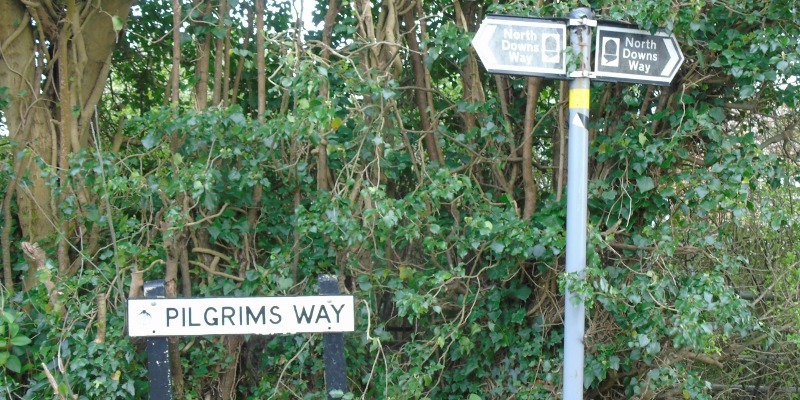Walking a Pilgrimage in Reverse

The week after Easter I took part in a pilgrimage walk from Canterbury Cathedral to Ashford, to mark the point where two good friends were concluding their time as ministers of one of Ashford’s churches.
It was lovely to be led by someone else, to enjoy the freedom given as others undertook the organising, route finding and group management. Around thirty people took part in the walk, mostly members of the church’s congregation, and we were generously supplied with hospitality and refreshments along the route.
What was interesting for me is that normally Canterbury Cathedral is the end point of a pilgrimage walk. Canterbury has been a pilgrim destination ever since Augustine founded his monastery here in the sixth century. It became a major centre of pilgrimage after the murder of Thomas a Becket in the Cathedral during the reign of Henry II.
But on this occasion Canterbury was the starting point. The finishing point - if the citizens of Ashford will forgive me for saying this – is not widely recognised of being of such spiritual significance as the great cathedral city. It felt as though this was a ‘pilgrimage in reverse’.
So here are some reflections on the value of doing pilgrimage ‘the other way round’.
Firstly, one of the aphorisms about pilgrimage is that the journey is more important than the destination. It’s about what happens to you along the way. The beginning or end points are often of much less significance. So a pilgrimage can be from anywhere to anywhere. It’s more the attitude and approach that the pilgrim brings which give the walk its power.
I also believe that from time to time it’s helpful to step out of the box and the normal way of doing things, to take a different perspective. It is when you do a regular activity differently that you learn. Inevitably you’re forced to reflect upon the experience and compare it with doing things ‘the right way’.
I wouldn’t have written this reflection if we’d walked the normal way to finish in Canterbury Cathedral, or at least it would have been a very different reflection. So why not consider doing an activity which is a regular habit or pattern in reverse, or by a different method, to see what learning there might be in the experience?
On a spiritual level, as it was the Easter season, my friends invited us to consider the journey of the two walkers who left Jerusalem for their home of Emmaus, the day of Jesus’ resurrection from the dead. They were walking their pilgrimage route in reverse, leaving the great city and returning to a small village where they lived.
But it was on their homeward journey that they encountered Jesus and their lives were forever changed. Their hitherto disastrous and traumatic pilgrimage to Jerusalem was transformed when they walked home and took the pilgrimage in reverse. You can read this story at the end of Luke’s Gospel, in chapter 24. It makes for a good read to accompany a pilgrimage walk.
I also reflect on the advice often given to pilgrims on the Camino de Santiago, that the real work happens when one returns home. It’s the task of integrating the gifts, blessings and learnings of the pilgrimage walk into everyday life. Medieval pilgrims had a long return journey with which to do this. Most modern pilgrims jump on a train or plane and are home the next day, so they need to find time and space to reflect on their experience and work out how they embody it in regular ordinary daily life. A ‘reverse pilgrimage’ might enable this.
A final, more theological thought. Canterbury is the seat of the Archbishop, a place historically of power and influence. The grandeur of the cathedral and its precinct is a reminder of the wealth that pilgrimage has brought to this city. I was leaving this behind and heading out into the quiet countryside of the Great Stour valley, walking to a smaller provincial town.
This spoke to me of the journey which Jesus himself undertook, which Christians ponder and celebrate at Christmas, of leaving the glory of heaven and coming into our broken and troubled human world. His life demonstrated a continual refusal to lay power, wealth and influence aside, to take a different road of humility, weakness and suffering. Those who follow him likewise are called to walk this counter-cultural path.
So next time you consider taking a walk, most especially a pilgrimage walk, try journeying ‘in reverse’ and see what the experience gives you. I am confident that you will find it rewarding.
April 2024